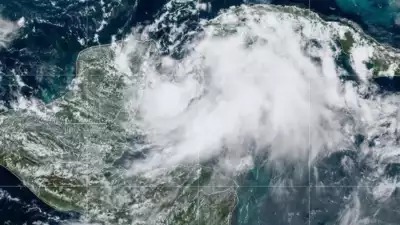Hurricane Idalia on Wednesday slammed into the Big Bend region of Florida, where millions of residents had evacuated or hunkered down in anticipation of a dangerous surge of tidal water, but the storm’s power ebbed as it headed toward Georgia.
Drawing strength from the Gulf of Mexico’s warm waters, Idalia unleashed destructive winds and torrential downpours that were forecast to cause coastal flooding up to 16 feet (5 m) deep along the state’s Gulf Coast.
Idalia came ashore at 7:45 a.m. EDT (1145 GMT) at Keaton Beach, a town of 13,000 people in Taylor County, in the center of the Big Bend region, where the state’s northern panhandle curves into the Florida Peninsula.
“It’s just ripping through Taylor County now. Hope all is safe,” County Commissioner Jamie English said by telephone. “Winds gusting. Terrible power outages all over. Debris flying everywhere.”
The storm’s most dangerous feature would be a powerful surge of wind-driven surf that is expected to flood low-lying areas along the coast, officials said.
Surge warnings were posted for hundreds of miles of shoreline, from Sarasota to the western end of Apalachicola Bay. In some areas, the surge could rise as high as 16 feet, the National Hurricane Center (NHC) said.
“If you end up with a storm surge that even approaches 16 feet, the chances of surviving that are not great,” Florida Governor Ron DeSantis said. “You would need to be in a three-story building because it is going to rise very, very high.”
There were few early reports of flooding available. By midmorning, a National Oceanic and Atmospheric Administration monitoring station in Steinhatchee, 20 miles (32 km) south of Keaton, showed waters reaching 8 feet, well above the 6-foot flood stage. Stations in the more densely populated Tampa area showed water levels at a “minor flooding” stage at 10 a.m.
In Hillsborough County, an area of 1.5 million people south of the Big Bend region that includes Tampa, crews were dealing with widespread damage and flooded streets, officials said in a news briefing.
“Folks, this storm is not over. If you are in a safe location, please remain there,” said Emergency Management Director Timothy Dudley, noting that local waterways would crest at high tide at 2:30 p.m.
All night, howling winds and seemingly endless sheets of rain pelted the house of Mark Feinman’s in-laws in St. Petersburg, where he had evacuated with nine other people and two cats, heeding the orders to get to higher ground.
“We didn’t flood, so far, so hopefully we ducked the worst of it,” he said in a telephone interview.
Overnight, attained “an extremely dangerous Category 4 intensity” on the five-step Saffir-Simpson wind scale, but by 7 a.m. the storm weakened slightly into Category 3 with maximum sustained winds of 125 mph (201 kph), the NHC said.
By 11 a.m. EDT, maximum sustained winds had ebbed to 90 mph (150 kph), reducing the tempest to a Category 1 storm as it approached southeastern Georgia, the NHC said.
DANGER TO LIFE
Most of Florida’s 21 million residents, and many in the adjacent states of Georgia and South Carolina, were under hurricane warnings and other storm-related advisories. State emergency declarations were issued in all three.
Two motorists died in separate rain-related crashes on Wednesday morning, according to the Florida Highway Patrol.
Some over 275,000 homes and businesses were without power in Florida as of midday, Poweroutage.us reported. More than 64,000 in Georgia were also without power.
Florida’s Gulf Coast, southeastern Georgia and eastern parts of North and South Carolina could face 4 to 8 inches of rain through Thursday, with isolated areas seeing as much as a foot of rain, the hurricane center warned.
GOVT RESPONSE
At the White House on Tuesday, U.S. President Biden said he and DeSantis, who is seeking the Republican nomination to challenge Biden in the 2024 presidential election, were “in constant contact” about storm preparations.
Biden was set to speak about the government’s hurricane response efforts later on Wednesday.
Deanne Criswell, the U.S. Federal Emergency Management Agency’s administrator, said on Wednesday morning that more than 1,000 personnel from FEMA’s rapid assessment teams were ready to hit the ground to assess storm damage once Idalia passes.
Criswell also warned residents of neighboring Georgia and South Carolina to be prepared and listen to local officials.
“Time will tell on how bad it is… and we could have more” storms, she said, adding that it has been “a very active hurricane season.”
Idalia grew from a tropical storm into a hurricane early on Tuesday, a day after passing west of Cuba, where it damaged homes, knocked out power, flooded villages and prompted mass evacuations.
It was the fourth major hurricane to strike Florida in the past seven years, following Irma in 2017, Michael in 2018 and Ian, which peaked at Category 5, last September.
































